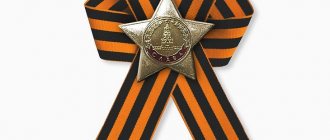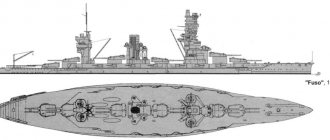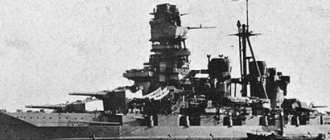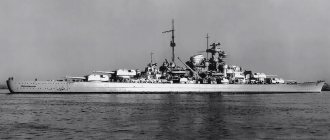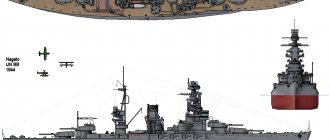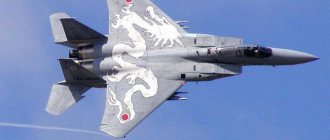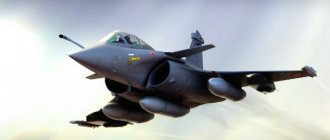Japanese Navy (2019)
Colonel V. Volodin
Japan, being an island state, pays increased attention to the development of its national naval forces (the official name is the Maritime Self-Defense Force). At the same time, the Japanese command sets the following main tasks for the Navy: protecting sea communications, fighting enemy naval groups, blocking strait zones, protecting bases, bases, ports and remote island territories, providing anti-amphibious defense, amphibious landings and organizing maritime transport.
The general leadership of the country's naval forces is carried out by the commander (the full-time category of admiral), who is also the chief of staff of this type of self-defense forces.
Into the structure of the naval forces
includes: headquarters, fleet, five naval regions (NMR), aviation training command, formations, units and institutions of central subordination (squadron of training ships, communications brigade, naval military police department, information security department (counterintelligence), logistics department provision of the Navy and six military educational institutions).
The headquarters of the Navy is located in Tokyo, in common with the Ministry of Defense and the headquarters of the Army and Air Force, in the Ichigaya administrative complex. Its staff number is about 700 people.
The fleet is an operational formation to which the headquarters (at the Yokosuka naval base), three commands (submarine forces, escort forces and aviation), a flotilla of minesweepers, an oceanography and anti-submarine defense group, an experimental group, and a reconnaissance group are subordinated. The staff category of commander is vice admiral.
Submarine Command
- an association whose structure includes 2 flotillas (based in the Kure and Yokosuka naval bases), a submarine training division (consisting of two submarines withdrawn from service) and a training center for submariners. Commanding Vice Admiral, Headquarters Yokosuka Naval Base. Subordinate to the commander of each flotilla (rear admiral) are: the headquarters, the submarine floating base as the flagship, 3 submarine divisions (2-4 ships each), as well as the base detachment.
Escort Forces Command
- unification of the Navy. Organizationally, it includes a headquarters (Yokosuka naval base), 4 flotillas of destroyers (based in Yokosuka, Sasebo, Maizuru and Kure naval bases), 7 separate divisions (destroyers - 3, frigates - 2, supply transports - 1, combat training support ships - 1), as well as a personnel training group. Commanding Vice Admiral. The commander of each flotilla (rear admiral) is subordinate to the headquarters and 2 divisions of destroyers (4 ships each).
Individual divisions consist of 2-5 ships (vessels). Destroyers (frigates) of a division are based in the same naval base. Vessels of the supply transport division are assigned to different bases.
Fleet Air Command
includes headquarters (AvB Atsugi), 7 air wings (1, 2, 4, 5, 21, 22 and 31st), 3 separate air squadrons (51st experimental, 61st transport aviation and 111th minesweeper helicopters), 4 detachments (helicopter - 1, aircraft repair - 2 and air traffic control - 1), as well as a mobile engineering company (AvB Hachinohe). The staff category of the commander vice admiral, chief of staff and air wing commanders is rear admiral.
The flotilla of minesweepers organizationally includes: headquarters, 4 divisions (1, 2, 3 and 101st) of 2-4 ships each, 2 floating bases of minesweepers, as well as a division of landing ships (1st) consisting of 9 ships and boats.
The oceanography and anti-submarine defense group includes a headquarters, an anti-submarine defense center (Yokosuka) and 2 detachments of ships: hydrographic and sonar observation.
Experimental group
(the full-time category of commander rear admiral) consists of a headquarters (Yokosuka), a division of experimental ships, three development centers: control and communication systems, ships, automated control systems for naval aviation, as well as a test laboratory for ship weapons (Kagoshima).
Intelligence Group
Organizationally, it includes a headquarters and 3 departments (operational information, information-analytical and electronic intelligence). It is engaged in the collection and analysis of intelligence data, the preparation of information reports, and the planning of activities for the organization of naval radio and electronic intelligence.
The entire coast of Japan and its adjacent territorial waters are divided into five naval regions (Yokosuka, Kure, Sasebo, Maizuru and Ominato). The BMP is headed by a commandant (staff category vice admiral), to whom, in addition to the main formations and units, the commanders of naval bases (base points - PB), coastal units and services responsible for the basic support of ships and naval vessels are administratively subordinate. Organizationally, the naval area includes: headquarters, naval base, 1-2 PB (in BMP Kure - Hanshin, in Sasebo - Katsuren (Okinawa) and Shimonoseki, in Ominato - Yoichi and Hakodate), 1-2 separate minesweeper divisions, a separate missile division boats (in the naval forces of Sasebo, Maizuru and Ominato), points (in Sasebo additionally - a center) for monitoring the surface and underwater situation, up to 3 basic detachments, individual ships and vessels, as well as coastal units and services. The BMP is entrusted with the tasks of protecting and defending bases, security posts, ports and water areas, patrolling, maintaining the operational regime, monitoring the surface and underwater situation, participating in the blockade of strait zones, as well as logistics support.
Naval Air Training Command
organizationally includes headquarters (AvB Simofusa), 3 training aviation wings (each as part of a training air squadron: Shimofusa - P-3C aircraft, Tokushima - TS-90, Otsuki - T-5 and airfield technical support groups), as well as 2 separate training helicopter squadrons. The staff category of commander is vice admiral.
In combat personnel of the Navy
there are: 7 flotillas (submarines - 2, destroyers - 4 and minesweepers - 1), a squadron of training ships, 5 detachments of auxiliary ships, an oceanography and anti-submarine defense group, an experimental group, 17 separate divisions (submarines - 1, destroyers - 3, frigates - 2, minesweepers - 6, missile boats - 3, combat training support ships - 1 and supply transports - 1), 6 squadrons of combat aircraft (electronic warfare - 2, patrol - 4), 6 squadrons of auxiliary aircraft, 8 helicopters squadrons (combat helicopters - 6, auxiliary aviation helicopters - 2).
In service
The naval forces have 94 warships of the main classes, about 80 basic patrol aircraft (BPA) R-3C and R-1, as well as 110 combat helicopters.
The Navy's authorized strength is 45,400 military personnel. The permanent reserve numbers 1,100 people (formed from volunteers discharged from military service due to length of service and expiration of the contract).
Reserve component of the fleet
There is also a maritime security department (more than 13,740 people), whose forces and means can be used in wartime in the interests of the Navy. It has at its disposal 134 patrol ships, 238 patrol boats, up to 100 auxiliary vessels (boats), over 70 aircraft and helicopters.
Ship composition.
The most numerous types of ships of the main classes are submarines, destroyers and minesweepers.
| Reference data “Ship composition of the Japanese Navy” () |
The submarine force has 19 diesel submarines: 10 Soryu-class (surface displacement 2,900 tons) and nine Oyashio-class (built 1998-2008, 2,750 tons). Each is equipped with six 533 mm torpedo tubes. In addition to torpedo weapons, there are Harpoon anti-ship missiles (ASMs), as well as sea mines.
In terms of their tactical and technical characteristics, Japanese submarines correspond to the best foreign models. Features of the Soryu type boats are that they are equipped with an air-independent power plant (four Stirling engines with electric generators), as well as an X-shaped arrangement of the stern rudders.
The main and most numerous class of surface ships in the fleet are destroyers (42 ships of 11 types). The largest of them are helicopter destroyers (EMV) of the Izumo type (standard displacement 19,500 tons, total displacement - 24,000 tons, length 248 m, width 32 m, draft 7.5 m, maximum speed 30 knots, crew approx. 470 people) and "Hyuga" (standard displacement 13,500 tons, gross displacement - 18,300 tons, length 197 m, width 32 m, draft 6.3 m, maximum speed 30 knots, crew of about 350 people).
Destroyers-helicopter carriers perform the functions of combat control of groups of heterogeneous forces. They are designed to combat enemy submarines, provide rescue operations and provide humanitarian assistance. The design features and characteristics of the Hyuga and Izumo-type EMVs facilitate the placement of various types of aircraft on them, including the MV-22 Osprey transport and landing aircraft.
Destroyers of the Hatakaze, Kongo and Atago type with guided missile weapons. The latter two are equipped with the Aegis multifunctional weapon control system (MSWS), which ensures the effective use of weapons, including Standard-type missiles, as well as Asrok anti-ship and anti-submarine missiles.
Of the six types of destroyers, the most modern are the Asahi-class ships (2018 and 2022). They are based on a modified Akizuki design. The standard displacement of the EM is 5,100 tons, the total displacement is 6,800 tons, length is 151 m, width is 18.3 m. The ship is equipped with a combined COGLAG type power plant, which includes two LM2500 gas turbine units, and can reach a maximum speed of 30 knots. Crew 230 people. Armament: Mk41 vertical launch systems (VLS) with 32 cells, SSM-1B anti-ship missile launchers, 127 mm gun mount (AU), two 20 mm Phalanx anti-aircraft artillery systems (ZAK), two three-pipe 324 mm TA, and also the SH-60 anti-submarine helicopter.
The frigates are represented by six Abukuma-class ships, the deliveries of which were completed in 1993. They are equipped with the Harpoon anti-ship missiles, Asrok anti-ship missiles, 76-mm AU, Phalanx ZAK and two three-pipe TA.
Landing ships include landing helicopter dock ships (DVKD), as well as small landing ships (MDK) type “No. 1”.
Japan's mine sweeping forces consist of sea minesweepers of the Awaji type (2 units) and the basic ones - Hirashima (3), Enoshima (3), Sugashima (12) and Ieshima (2). Armament: contact, acoustic and electromagnetic trawls, remote-controlled mine action devices and hydroacoustic mine detection stations.
The construction of a series of sea minesweepers of the Awaji type (standard displacement 690 tons, length 67 m, width 11, draft 2.7, speed 14 knots, crew 60 people) has been underway since 2013. The ship's armament: JM61-RFS artillery mount, deep-sea contact and non-contact trawls, S-10 anti-submarine underwater vehicle, and ZQS-4 sonar mine detection system. High-strength plastic was used in the construction of the minesweeper's hull.
The combat boats are represented by six Hayabusa-class missile boats (built 2002-2004, displacement 200 tons), armed with four SSM-1B anti-ship missiles, 76-mm OTO Melara AU, and six landing hovercraft of the No. 1".
Recruiting and training of Japanese Navy personnel.
Men and women between the ages of 18 and 23 who are Japanese citizens, have a high school education, are physically fit, and have passed a security check are accepted to serve in the national navy. The duration of active service under the primary contract is 3 years. Those wishing to continue serving can take an exam to advance to the senior officer category.
Enlisted personnel undergo training in training units included in the BMP Yokosuka, Kure, Sasebo and Maizuru (training period is 3 months). For certain specialties, selected sailors are sent for additional training to technical schools located in the cities of Yokosuka, Maizuru, Shimofusa and Etajima (training from 10 weeks to a year).
Petty officers undergo training at a junior school (4 years), at training courses at technical schools (3 months) and in training detachments (2 years). The most prepared petty officers with the rank of chief petty officer are sent to a monthly course for midshipmen or to an officer candidate school (6 months).
The officer training program includes: primary training, training of command and engineering personnel, improvement of qualifications in the process of combat training in formations and units.
Primary training of officers is carried out by military and military medical colleges (training duration is 4 and 6 years, respectively), as well as the Navy Officer Candidate School (from 6 to 12 months). Graduates of the latter receive the primary officer rank and undergo an internship during a training voyage for 8 months. Upon completion, depending on the complexity of the chosen profession, additional training is provided (from 5 weeks to 1 year) in technical schools, centers and institutes.
During the period of service, almost all officers attend retraining courses for mid-level officers at military educational institutions for a year.
Senior command and engineering personnel are trained at the Naval Command and Staff College (training period is one year), where there are also one-year higher officer courses, and senior command personnel are trained at the Joint Staff Command and Staff College.
In 2022, the Japanese Ministry of Defense lifted restrictions on female military personnel serving in the submarine force. According to the revised standards, they can staff up to 10% of submarine crews.
Operational and combat training (OCT) of the Navy
is aimed at improving the practical skills of command personnel and staffs in organizing and conducting combat operations at sea, maintaining high combat readiness of naval forces, increasing the level of interoperability with other types of national armed forces and the 7th operational fleet of the US Navy, mastering new weapons systems and military equipment ( IWT) and methods of their use.
The most important OBP events include: command post exercises of command and control bodies of naval formations and formations, final maneuvers of the Kaien naval forces, Japanese-American exercises of escort, submarine and mine-sweeping forces "Asvex" and "Mineks". For practical testing of combat training issues, naval combat training zones in the waters of the East China and Japan Seas, the Pacific and Indian Oceans, as well as the Korean and Sangar Straits are used.
A necessary element of the OBP are long-distance voyages of detachments of combat and training ships of the Habei Kunren type to the areas of the island. Guam and the West Coast of the USA, as well as to Southeast Asia.
These events, in the opinion of the command of the Japanese Navy, will contribute to the mastery of the crews of ships in ocean and sea theaters of war, increasing their maritime and special training, obtaining practical skills by cadets and graduates of naval educational institutions, as well as demonstrating the flag and strengthening ties with the fleets of other states
Prospects for the construction of the Japanese Navy.
In order to maintain the ship's composition at a high level of readiness and its renewal, an average of one diesel submarine, one destroyer and a basic minesweeper are commissioned annually.
Since 2013, the P-3C Orion base patrol aircraft have been replaced with similar Japanese P-1 aircraft.
By 2030, it is planned to equip four UAV squadrons with them (about 60 units in total). The Navy's helicopter fleet is being updated by replacing SH-60J anti-submarine helicopters with SH-60K and supplying MSN-101 minesweeper helicopters.
In accordance with the national defense program (2019-2029), approved by the Japanese government in December 2022, and the medium-term plan for the construction of the armed forces (2019-2024), the main efforts of the naval command are planned to be focused on optimizing the organizational structure of the fleet, updating the ship composition and aviation park, improving the logistics system, maintaining weapons and military equipment in readiness for combat use, as well as increasing the level of training of personnel.
The most significant structural changes will occur in connection with the formation of aircraft carrier forces, the 14th division of destroyers, a center of naval operations, formed in the interests of increasing the efficiency of managing fleet forces within the framework of independent, as well as joint actions with other types of armed forces and the American Navy.
It is proposed to create an aircraft carrier strike component through the conversion of two Izumo-class helicopter destroyers into light aircraft carriers, which will be capable of hosting American-made F-35B Lightning-2 deck-based tactical fighters with short/vertical take-off and landing. During the modernization, the ship's design will not change significantly. The main work will consist of applying a special coating resistant to high temperatures to the flight deck, as well as improving elevator equipment.
To ensure constant control over the waters adjacent to Japan and the airspace above them, it is planned to adopt multifunctional, advanced destroyers and new types of submarines, as well as patrol ships.
In this regard, it is planned to place orders for the construction of 23 warships and auxiliary vessels, including five submarines and 10 destroyers, 12 P-1 base patrol aircraft and 13 SH-60K anti-submarine helicopters.
In the interests of updating the ship's personnel, by 2022 the number of submarines is planned to be increased to 23 units (including 2 training ones).
At the same time, it is planned to build a new type of submarine with a displacement of 3000 tons (laying down the first is scheduled for 2022, commissioning - for 2023). By 2027, it is planned to put 5 submarines into service with the Navy.
At the same time, it is planned to begin the construction of Project 30DX frigates with a standard displacement of 3900 tons to combat low-noise enemy submarines in the near sea zone. The subcontractor is a shipbuilding company. The FR will be equipped with a power plant consisting of a British MT30 gas turbine engine and two German-made 12V28/33D-STC diesel engines with a total power of about 80,000 hp. With. Main weapons: UVP for the Asrok anti-missile missile, Sea Ram missile launcher, anti-submarine helicopter, remotely controlled boat and underwater vehicle. Detection and reconnaissance equipment will include a sonar station of variable immersion depth, a hydroacoustic station (GAS) with a passive towed antenna, a stern mine search sonar, as well as an optical-electronic system for detecting surface targets.
By 2022, it is planned to increase the number of ships capable of solving missile defense problems to eight units. In addition to four Kongo-class guided missile destroyers, this year it is planned to complete the modernization of two similar Atago-class ships, and in 2021-2022, two new Maya-class guided missile destroyers will be introduced into the fleet. The ship's standard displacement is 8,200 tons (full - 10,000 tons), length 170 m, width 21, draft 6.3, maximum speed 30 knots, cruising range at an economical speed of 16 knots - 6 thousand miles, crew 340 people. Armament: 2 UVP Mk41, PLUR "Asrok", 2 four-container anti-ship missile launchers SSM-1B, 2 three-tube 324 mm TA and 127 mm AU Mk45 mod. 4. In addition, two anti-submarine helicopters are provided on board.
In 2022, in the interests of the Navy, it is planned to begin construction of patrol ships with a displacement of 1,000 tons, the main task of which will be to monitor the situation around the Japanese Islands, primarily in the area of the Senkaku Islands (Okinawa Prefecture). By 2032, it is planned to build 12 such ships.
In general, according to Japanese experts, the Japanese naval forces have sufficient combat capabilities to protect the country from armed aggression, both independently and in cooperation with other types of self-defense forces and the US Armed Forces. At the same time, equipping them with modern weapons and military equipment will make it possible for the long term to maintain the status of one of the leading militarily states in the Asia-Pacific region.
Thus, the Japanese Navy has a fairly high level of combat capabilities to protect the country from armed aggression, both independently and in cooperation with other types of “self-defense forces” and the US Armed Forces. At the same time, equipping them with modern weapons and military equipment will allow Japan to maintain the status of one of the leading militarily states in the Asia-Pacific region for the long term.
Foreign military review. - 2022. - No. 8. — P. 64-73
National flags[edit]
Main article: Flag of Japan
| Flag | date | Use | Description |
| August 13, 1999 - present | Civil and state flag and ensign of Japan. | Flag ratio: 2:3. This flag was designed by Proclamation No. 127, 1999. The sun disk is perfectly centered and has a brighter shade of red. | |
| February 27, 1870 - August 12, 1999 | Civil and state flag and flag of the Japanese Empire and the Japanese State. | Flag ratio: 7:10. The disc is shifted 1% towards the lift (left). This flag was designed by Proclamation 57 of 1870. |
Minorities [edit]
| Flag | date | Use | Description |
| (1996) 1994– [ quote needed ] | Flag of Mindan | Flag of Mindan, of the pro-Southern Zainichi Koreans organization. The pink flower surrounding the daegeuk is the Syrian hibiscus, the national flower of South Korea. The official name of the society ( Zainihon Daikanminkoku Mindan ) is written in Kanji in white, while the abbreviation ( Mindan ) is written in Hangul in yellow. The blue field of the flag means clear skies and seas. | |
| 1923–1945 [ link needed ] | Flag of the National Equalization Association/Buraku Liberation League | Flag of the National Levelers Association, a Burakumin human rights group, and the Buraku Liberation League, a subsequent NLA group. Called the Flag of the Crown of Thorns (荊冠, Keikanki). Black represents a dark society with discrimination. The color red represents blood. | |
| 1945– [ link needed ] | Flag of the Buraku Liberation League | The current flag of the Buraku Liberation League with a white star representing hope. |
Cultural flags[edit]
| Flag | date | Use | Description |
| 1919– | Safety flag | Called the Green Cross (緑十字, Midori-zuji). Created by Toshifumi Gamo as a symbol of the government's "Safety Week" campaign. The cross symbolizes charity in the Western sense and a place where good deeds gather in the Eastern sense. JIS Z9103-1986 designates this symbol as a safety sign. | |
| 1953– | Industrial hygiene flag | Announced by the Bureau of Labor Standards of the Japanese Ministry of Labor (now the Ministry of Health, Labor and Welfare) by public subscription. | |
| 1965– | Safety and health flag | Developed by the Japan Industrial Safety and Health Association. These three flags are often displayed at factories or construction sites. | |
| 1886– | Postal flag | Postal symbol 〒 on a white field. |
Imperial flags[edit]
| Flag | date | Use | Description |
| 1868–present | Imperial Standard of the Emperor of Japan | 16 petal chrysanthemum, painted gold, on a red background | |
| 1926–present | Imperial Standard of the Regent of Japan | Similar to the Emperor's standard, but with a white border. | |
| 1926–present | Imperial Standard of the Empress, the Empress Dowager, and the Grand Empress Dowager | Imperial Standard Pennant | |
| 1926–present | Imperial Standard of the Crown Prince and the Imperial Grandson heir apparent | Similar to the Emperor's standard, but with a white eagle. | |
| 1926–present | Imperial Standard of the Crown Princess and Wife of the Imperial Grandson | Pennant of the Crown Prince's Standard | |
| 1926–present | Imperial standard of other members of the Imperial House | Golden 16-petalled chrysanthemum on a white background with a red border |
Historical flags[edit]
| Flag | date | Use | Description |
| 19th century | Naval flag of the Tokugawa shogunate [1] | A two-color flag consisting of three stripes; white, black and white. | |
| 1905–1910 | Flag of the Resident General of Korea | Blue Ensign with the flag of Japan in the canton | |
| 1945–1952 | Civil and naval ensign during the occupation of Japan | Derived from the International Maritime Signal Flag "E" | |
| 1950 (January–March) | Proposed flag of Okinawa | Called the Okinawa Flag (沖縄縄) or the Ryukyu Flag (琉球), proposed by the Okinawa civilian government. The US administration said that a decision on the flag will be made after the creation of a unified government of the islands. However, since then the flag has been forgotten. Red, white and blue symbolize peace, freedom and enthusiasm respectively. The star represents hope. | |
| 1952–1967 | Civil ensign during the occupation of Okinawa | Derived from the international maritime signal flag "D" | |
| 1967–1972 | Civil Ensign of the Ryukyu Islands Government | The Ryukyu pennant over the Japanese flag was used during the US occupation of the Ryukyu Islands. |

